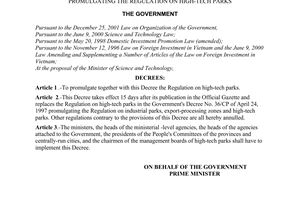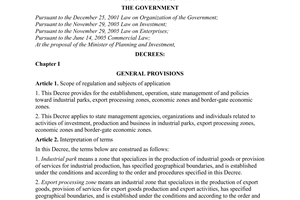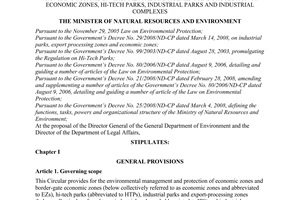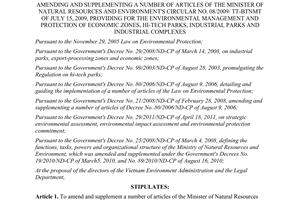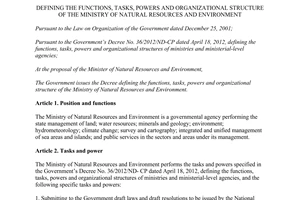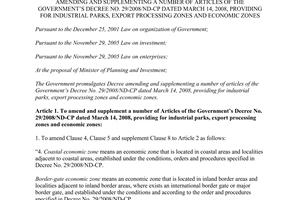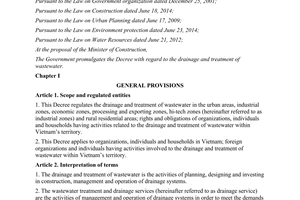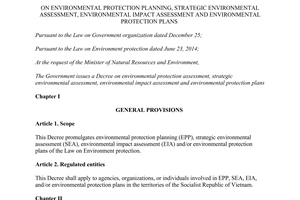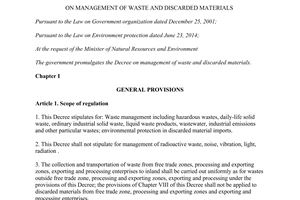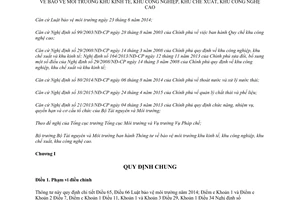Nội dung toàn văn Circular No. 35/2015/TT-BTNMT providing for the environmental protection of economic zones industrial parks
|
THE MINISTRY OF |
THE SOCIALIST REPUBLIC OF VIETNAM |
|
No. 35/2015/TT-BTNMT |
Hanoi, June 30, 2015 |
CIRCULAR
PROVIDING FOR THE ENVIRONMENTAL PROTECTION OF ECONOMIC ZONES, INDUSTRIAL PARKS, EXPORT PROCESSING ZONES AND HI- TECH PARKS
Pursuant to the June 23, 2014 Law on Environmental Protection;
Pursuant to the Government’s Decree No. 99/2003/ND-CP of August 28, 2003, promulgating the Regulation on hi-tech parks;
Pursuant to the Government’s Decree No. 29/2008/ND-CP of March 14, 2008, on industrial parks, export processing zones and economic zones; and Decree No. 164/2013/ND-CP of November 12, 2013, amending and supplementing a number of articles of the Government’s Decree No. 29/2008/ND-CP of March 14, 2008;
Pursuant to the Government’s Decree No. 80/2014/ND-CP of August 6, 2014, on water drainage and wastewater treatment;
Pursuant to the Government’s Decree No. 38/2015/ND-CP of April 24, 2015, on waste and scrap management;
Pursuant to the Government’s Decree No. 21/2013/ND-CP of March 4, 2013, defining the functions, tasks, powers and organizational structure of the Ministry of Natural Resources and Environment;
At the proposal of the Director General of Vietnam Environment Administration and the Director of the Department of Legal Affairs;
The Minister of Natural Resources and Environment promulgates the Circular on the environmental protection of economic zones, industrial parks, export processing zones and hi-tech parks.
Chapter I
GENERAL PROVISIONS
Article 1. Scope of regulation
This Circular details Articles 65 and 66 of the 2014 Law on Environmental Protection; Point e, Clause 1, and Point e, Clause 2, Article 7; Point c, Clause 1, Article 11; Clauses 1 and 3, Article 29; and Clause 1, Article 34, of the Government’s Decree No. 29/2008/ND-CP of March 14, 2008, on industrial parks, export processing zones and economic zones (below referred to as Decree No. 29/2008/ND-CP); and provisions on environmental protection of economic zones, industrial parks, export processing zones and hi-tech parks at Points a and c, Clause 1, Article 43 of the Government’s Decree No. 38/2015/ND-CP of April 24, 2015, on waste and scrap management (below referred to as Decree No. 38/2015/ND-CP).
Article 2. Subjects of application
This Circular applies to state management agencies and domestic and foreign organizations and individuals involved in environmental protection of economic zones; and industrial parks, export processing zones and hi-tech parks (below collectively referred to as industrial parks).
Chapter II
ENVIRONMENTAL PROTECTION OF ECONOMIC ZONES
Article 3. Assessment of the ability to satisfy environmental protection conditions upon establishment or expansion of economic zones
1. The agency proposing the establishment or expansion of an economic zone shall assess the economic zone’s ability to satisfy environmental protection conditions. Assessment contents and results shall be fully presented in the dossier for the establishment or expansion of the economic zone.
2. Assessment contents of the ability to satisfy environmental protection conditions are provided in Appendix 1 to this Circular.
Article 4. Appraisal of the ability to satisfy environmental protection conditions upon establishment or expansion of economic zones
1. Within twenty (20) working days after receiving a written request of the Ministry of Planning and Investment for appraisal of the dossier for the establishment or expansion of an economic zone, the Ministry of Natural Resources and Environment shall appraise the economic zone’s ability to satisfy environmental protection conditions, and notify in writing the appraisal results to the Ministry of Planning and Investment and related agencies for consideration and decision of the establishment or expansion of the economic zone.
2. Forms of appraisal:
a/ Verifying and assessing information, data and analysis and assessment results;
b/ Surveying the environmental status of the sites where economic zones are expected to be established or expanded. In case of necessity, carrying out measurement and taking samples for analysis and verification;
c/ Consulting related organizations and individuals.
Article 5. Technical infrastructure facilities for environmental protection of economic zones
1. The agency proposing the establishment or expansion of an economic zone shall plan, build and operate technical infrastructure facilities for environmental protection of the economic zone prescribed in Clause 2 of this Article and notify such in writing to the Ministry of Natural Resources and Environment for monitoring and inspection under regulations.
2. Technical infrastructure facilities for environmental protection of an economic zone include:
a/ Solid waste collection, storage and disposal system;
b/ Rainwater collection and drainage system; wastewater collection, drainage and treatment system;
c/ Network of surrounding environment quality observation sites;
d/ Greenery coverage;
dd/ Other technical infrastructure facilities for environmental protection.
Article 6. Environmental protection upon adjustment of plans of economic zones
1. When adjusting a plan of an economic zone, in case of necessity, competent agencies may consult the Ministry of Natural Resources and Environment on the economic zone’s ability to satisfy environmental protection conditions.
2. Assessment contents of the ability to satisfy environmental protection conditions upon adjustment of a plan of an economic zone are provided in Appendix 2 to this Circular.
3. Within twenty (20) working days after receiving a written request, the Ministry of Natural Resources and Environment shall consider and send written opinions to agencies competent to decide on adjustment of plans of economic zones. In case of necessity, the Ministry of Natural Resources and Environment may conduct field assessments and collect opinions of related organizations and individuals.
Chapter III
ENVIRONMENTAL PROTECTION OF INDUSTRIAL PARKS
Article 7. Environmental protection requirements in industrial park construction planning
1. A plan on functional quarters within an industrial park must ensure minimum impacts of polluting production activities on other production activities and facilitate the prevention of and response to environmental incidents.
2. Projects in an industrial park must ensure an environmental safety distance according to national technical regulations on technical infrastructural facilities to mitigate possible impacts on other establishments in the industrial park and surrounding socio-economic subjects.
3. Technical infrastructure for environmental protection shall be arranged in a way suitable to various forms of investment in an industrial park, ensuring minimum bad impacts on surrounding environment.
4. Greenery coverage in an industrial park must account for at least 10 percent of the industrial park’s total area.
Article 8. Construction of technical infrastructure for environmental protection of industrial parks
1. Technical infrastructure for environmental protection of an industrial park includes the rainwater drainage system, centralized wastewater treatment system (including the wastewater collection system, centralized wastewater treatment plant, and wastewater drainage system), solid waste storage area (if any), automatic wastewater observation system and other technical infrastructure facilities for environmental protection. Technical infrastructure for environmental protection of an industrial park shall be synchronously designed and conformable with construction technical regulations and relevant environmental technical regulations.
2. A water drainage system in an industrial park must satisfy the following requirements:
a/ The wastewater collection and drainage system is separated from the rainwater drainage system;
b/ Manholes of the wastewater collection and drainage system must be located at positions and have depths for easy connection to establishments’ wastewater discharging points and ensure the industrial park’s wastewater drainage capacity; the wastewater connection points must lie along the collection route of the water drainage system of the industrial park and outside the premises of establishments;
c/ The discharging point of the centralized wastewater treatment system of the industrial park at receiving waters must be outside the fence of the industrial park with signs and a working area of at least one (1) square meter and a convenient passage for the inspection and control of waste sources.
3. A centralized wastewater treatment plant of an industrial park must meet the following requirements:
a/ Being divisible into various modules suitable to the schedule of occupancy and operation of the industrial park but ensuring treatment of the whole generated wastewater volume up to environmental technical regulations; having an input wastewater flow meter and an independent electric meter. Application of environment-friendly and energy-efficient technologies is encouraged;
b/ Having a system for automatic and constant observation of the output wastewater flow, pH, temperature, COD, TSS and some other typical parameters of wastewater generated by the industrial park before wastewater is discharged into receiving waters according to the requirement specified in the decision approving the environmental impact assessment report. The automatic observation system must ensure automatic and constant transmission of data to the provincial-level Department of Natural Resources and Environment.
4. The centralized wastewater drainage and treatment system and rainwater drainage system of an industrial park shall be completely constructed before the industrial park is put into operation.
Article 9. Industrial park wastewater management
1. Wastewater of production, business and service establishments operating in an industrial park:
a/ Wastewater shall be treated to meet the conditions specified in written agreements signed with the owner of the industrial park infrastructure construction and commercial operation project before being connected to the collection system of the industrial park for further treatment at the centralized wastewater treatment plant up to environmental technical regulations before being discharged into receiving waters, except the case provided in Clause 4 of this Article;
b/ Production, business and service establishments operating in an industrial park that transfer wastewater to a functional unit for treatment must sign wastewater treatment contracts with the functional unit under current regulations.
2. The rainwater and wastewater collection networks and drainage systems shall be regularly maintained and repaired to ensure normal operation.
3. Management and operation of a centralized wastewater treatment plant:
a/ Each module or the whole of the centralized wastewater treatment plant shall be constantly operated according to the approved technological process to make sure all wastewater be treated up to environmental technical regulations; must have an operation diary for examination and inspection, which fully reflects the wastewater volume, used electricity amount, used chemical and sludge amount;
b/ Input wastewater flow meters and automatic observation devices must operate 24 hours a day and transmit data automatically and constantly to the provincial-level Department of Natural Resources and Environment;
c/ There must be at least three (3) managers of the operation of the centralized wastewater treatment plant, of whom the leading manager must possess a collegial or higher degree in environmental technology, chemical technology, biotechnology, or electricity or water supply or drainage technology.
4. Cases exempted from connection:
a/ Production, business and service establishments apply wastewater treatment measures complying with environmental technical regulations and the connection to the centralized wastewater collection and treatment system of the industrial park causes unreasonable costs to such establishments;
b/ Production, business and service establishments generate an wastewater volume beyond the receiving and treatment capacity of the centralized wastewater treatment system of the industrial park and concurrently apply wastewater treatment measures up to environmental technical regulations;
c/ Production, business and service establishments apply wastewater treatment measures up to environmental technical regulations and operate in an industrial park that has no centralized wastewater treatment system.
5. For the cases specified at Points a and b, Clause 4 of this Article, owners of such establishments shall agree with the owner of the industrial park infrastructure construction and commercial operation project on solutions for disconnection to treat wastewater by themselves and send a report according to Clause 7, Article 16 of the Government’s Decree No. 18/2015/ND-CP of February 14, 2015, prescribing environmental protection master plan, strategic environmental assessment, environmental impact assessment and environmental protection plan (below referred to Decree No. 18/2015/ND-CP) The report must cover:
a/ A written request and a report on solutions to disconnection for wastewater to be treated by the establishment itself according to the form provided in Appendix 3 to this Circular (together with the latest results of constant wastewater observation);
b/ A written agreement on disconnection with the owner of the industrial park infrastructure construction and commercial operation project.
6. Wastewater may not be diluted before reaching the discharging point as specified at Point c, Clause 2, Article 8 of this Circular.
Article 10. Management of exhaust gas and noise in industrial parks
1. Production, business and service establishments operating in an industrial park that emit exhaust gas and cause noise shall procure and install exhaust gas treatment and noise reduction systems conformable to environmental technical regulations.
2. Production, business and service establishments operating in an industrial park that emit exhaust gas on the list specified in the Appendix to Decree No. 38/2015/ND-CP shall register the exhaust gas source owner, observe exhaust gas automatically and constantly and transmit data to the provincial-level Department of Natural Resources and Environment.
3. Application of environment-friendly and energy-efficient technologies, especially in industries causing great air pollution, is encouraged.
Article 11. Management of ordinary solid waste and hazardous waste generated in industrial parks
1. Production, business and service establishments operating in an industrial park shall sort out ordinary solid waste, medical waste and hazardous waste; dispose of such waste themselves or sign collection and disposal contracts with qualified units in accordance with law.
2. Sludge of the centralized wastewater treatment plant and water drainage system of an industrial park and establishments operating therein shall be collected, transported and disposed of or recycled in accordance with regulations on sludge management.
Article 12. Prevention, response to and remediation of environmental incidents in industrial parks
1. An industrial park’s program on environmental management and supervision must include a plan on prevention, response to and remediation of environmental incidents with the following major contents:
a/ Identification and assessment of dangers of environmental incidents that may occur during the operation of the industrial park, circumstances for each type of dangers of environmental incidents that are likely to occur;
b/ Preventive measures for each environmental incident; measures to eliminate causes of environmental incidents;
c/ A plan on arrangement of on-the-spot forces to be ready to respond to and remedy each specific environmental incident circumstance; plan on training and drilling in the prevention, response to and remediation of environmental incidents;
d/ Installation and inspection of necessary equipment, tools and facilities for responding to environmental incidents;
dd/ Implementation mechanism, notification and alert methods and mobilization of manpower and equipment and facilities in and outside the industrial park to cope with environmental incidents of different levels; mechanism for coordination among related organizations and individuals in the area in responding to environmental incidents;
e/ Solutions to addressing environmental pollution when an environmental incident occurs;
g/ A plan to mobilize financial sources for the implementation of the plan on prevention, response to and remediation of environmental incidents.
2. Owners of industrial park infrastructure construction and commercial operation projects shall make and implement plans on prevention, response to and remediation of environmental incidents according to Clause 1 of this Article.
Article 13. Environmental protection upon adjustment of areas, plans and activities of industrial parks
1. During the construction and operation of an industrial park, when making any adjustment to the area, plan, technical infrastructure or list of business lines which is not required to make an environmental impact assessment report, the owner of the industrial park infrastructure construction and commercial operation project shall make a report under Clause 7, Article 16 of Decree No. 18/2015/ND-CP The report form is provided in Appendix 4 to this Circular.
2. Within twenty (20) working days after receiving the report, the competent agency shall consider and notify the result to the owner of the industrial park infrastructure construction and commercial operation project. In case of necessity, the competent agency may form a team to conduct field inspection and collect opinions of related specialists and agencies before making decision.
Chapter IV
RESPONSIBILITIES FOR ENVIRONMENTAL PROTECTION OF ECONOMIC ZONES AND INDUSTRIAL PARKS
Article 14. Responsibilities of an economic zone or industrial park management board
1. To establish a specialized section to organize the environmental protection of the economic zone or industrial park in accordance with law. The head of this section must satisfy the following conditions:
a/ Possessing a university or higher degree in environmental management; environmental science, technology and techniques; chemistry or biology;
b/ Having at least three (3) years’ experience in environmental work.
2. To draft a coordination regulation for environmental protection of the economic zone or industrial park between the economic zone or industrial park management board and the provincial-level Department of Natural Resources and Environment and the People’s Committee of the district, provincial city or town, and submit it to the People’s Committee of the province or centrally run city (below referred to as provincial-level People’s Committee) for approval.
3. To guide and inspect the owner of the construction and commercial operation of industrial park infrastructure project and production, business and service establishments operating in the economic zone or industrial park under its management in implementing environmental protection regulations; to detect and promptly report violations of the environmental protection law to competent state management agencies for settlement and handling; to mobilize forces to respond to and remedy environmental incidents occurring in the economic zone or industrial park.
4. To make a regular report on environmental protection of the economic zone or industrial park and send it to the provincial-level People’s Committee and the Ministry of Natural Resources and Environment before January 15 every year. The report form is provided in Appendix 5 to this Circular.
5. To publicize information on environmental protection of the economic zone or industrial park; to educate about and disseminate legal documents on environmental protection to the owner of the industrial park infrastructure construction and commercial operation project and production, business and service establishments operating in the economic zone or industrial park.
6. To coordinate with functional agencies in settling environmental disputes among production, business and service establishments operating in the economic zone or industrial park or organizations and individuals outside the economic zone or industrial park.
7. To jointly examine, inspect, and handle violations of environmental protection committed by the owner of the industrial park infrastructure construction and commercial operation project and production, business and service establishments operating in the economic zone or industrial park.
8. To implement environment management and protection in other economic zones and industrial parks under their assigned or authorized functions and tasks.
Article 15. Responsibilities of owners of industrial park infrastructure construction and commercial operation projects
1. To have a specialized section in charge of environmental protection meeting the following conditions:
a/ Having at least three (3) persons;
b/ The person in charge of environmental protection must possess a university or higher degree in environmental protection; environmental science, technology and techniques, chemistry; or biology and have at least two (2) years’ experience in environmental work.
2. To constantly operate technical infrastructure facilities of environmental protection of the industrial park and ensure greenery coverage in the industrial park as specified in Clause 4, Article 7 of this Circular.
3. To implement the environmental observation program in the industrial park in accordance with law.
4. To summarize and report on results of environmental observation and environmental protection in the industrial park and at production, business and service establishments operating therein to the economic zone or industrial park management board and the provincial-level Department of Natural Resources and Environment before December 31 every year. The report form is provided in Appendix 6 to this Circular.
Article 16. Responsibilities of project owners and owners of production, business and service establishment operating in industrial parks
1. Project owners and owners of production, business and service establishments operating in an industrial park shall reach and sign a written agreement on wastewater pipeline connection conditions with the owner of the industrial park infrastructure construction and commercial operation project; connect the establishments’ wastewater systems to the wastewater
collection system of the centralized wastewater treatment plant under the supervision of the owner of the industrial park infrastructure construction and commercial operation project, except cases specified at Point b, Clause 1, and Clause 4, Article 9 of this Circular.
2. The establishments mentioned in Clause 4, Article 9 of this Circular must have wastewater treatment systems conformable with environmental technical regulations, organize wastewater observation, and declare and pay environmental protection charges for wastewater in accordance with law.
3. To implement the environmental observation program, make reports in accordance with law, and notify observation results to the owner of the industrial park infrastructure construction and commercial operation project.
4. To discharge other environmental protection responsibilities in accordance with law.
Chapter V
IMPLEMENTATION PROVISIONS
Article 17. Effect
1. This Circular takes effect on August 17, 2015.
2. The Minister of Natural Resources and Environment’s Circular No. 08/2009/TT-BTNMT of July 15, 2009, providing for the environmental management and protection of economic zones, hi-tech parks, industrial parks and industrial complexes, and Circular No. 48/2011/TT-BTNMT of December 28, 2011, amending and supplementing a number of articles of Circular No. 08/2009/TT-BTNMT cease to be effective on the effective date of this Circular.
Article 18. Implementation responsibility
1. Vietnam Environment Administration shall guide and examine the implementation of this Circular, and regularly report on environmental protection of economic zones and industrial parks to the Ministry of Natural Resources and Environment for reporting to the Prime Minister.
2. Ministries, ministerial-level agencies, government-attached agencies, People’s Committees at all levels, provincial-level Departments of Natural Resources and Environment, economic zone and industrial park management boards and related organizations and individuals shall implement this Circular.
3. Funding for the state management of environmental protection in economic zones and industrial parks prescribed in this Circular shall be allocated from the environmental budget and other sources in accordance with law.
4. Any problems arising in the course of implementation of this Circular should be reported to the Ministry of Natural Resources and Environment for appropriate amendment and supplementation.-
|
|
MINISTER OF NATURAL |
* All appendices to this Circular are not translated.
